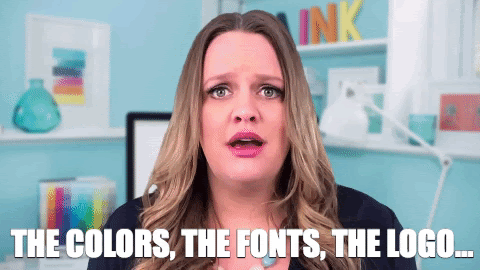If you’re not particularly tech savvy, don’t identify as a computer wizard, or find the idea of sitting down to sort out your business’ website just a plain headache, you’re certainly not alone! The world of websites, graphics, coding and content can be a confusing place, especially for novices. But there’s no need to beat yourself up about it or use it as an excuse to bypass the building of your business’ website entirely. Fortunately, there is so much help out there to get your website looking fly and working fine, starting with our five simple ways to improve your website (that every business should do).
1. Have a website (no matter how small you are)
It’s very tempting to get in the mindset that as a small business, you don’t actually need a website. Website’s take time and money to develop and then more time and money to maintain. But in our modern world, websites are one of the most important areas in your business to spend your time and money on.
Of course, as a marketer it’s no surprise I’m a big advocate for encouraging organisations to have an online presence, so if you don’t trust me, trust one of the biggest tech experts in the world. According to Brian Halligan, CEO and Co-founder of Hubspot, a marketing and sales software company, and senior lecturer at Massachusetts Institute of Technology (MIT), ‘people shop and learn in a whole new way compared to just a few years ago, so marketers [and businesses] need to adapt or risk extinction’.

2. Your website should contain at least four pages
And what are these four pages to include, you may well be wondering? Firstly, you will definitely need a homepage (you don’t need to be Brian Haillgan to know that!). Make your homepage as visual as possible (more on how to do this below). Imagine it as your shopfront if you have/ if you did have a bricks and mortar business space. It needs to reflect your brand, be easy to navigate as a user and provide a snapshot of what your business is all about.
Secondly, it’s important to include an About page. This is so visitors can find out more about the ins and outs of your business, how it all started and who made it possible. Here you can include your business’ values, details about accreditations you have, any charity work you do etc..
Thirdly, include a page about your products or services. Ideally this would consist of even more pages branching off, but if you’re just starting out and want to keep things simple, there’s nothing wrong with including all the info about what you provide customers or clients on a single page. This is the space where you can really let your business shine and sell, sell, sell.
Finally, but very importantly, you need to add a Contact page. This can be kept minimal and include all the ways you want your target customers/ clients to get in touch with you.

3. Use helpful tools to make your website look visually appealing
There are many ways you can make your website look visually appealing to suit all budgets. The most obvious way to do this is to hire a graphic designer. A quick Google search or browse on social media will pull up thousands of results for web designers, although probably the most reliable way you can find a professional to work with who you can trust is by asking around for recommendations (i.e. the good, old fashion way!).
If your budget can’t quite stretch to hiring an agency to do work for you, you can find graphic designers who will usually do the job for a little cheaper by looking on sites such as UpWork and Fiverr.
Alternatively, if you’re willing to have a go at designing a website yourself, but aren’t feeling too confident in your abilities, you can use online web building software such as SquareSpace and Wix.
The final method is to totally go it alone and build your website on WordPress (note: you’ll want to use the wordpress.org site, not wordpress.com). Here, you can use code to make your site look completely unique or download a plugin, such as Divi, and customise pre-built templates.

4. Write text that is informative and sets the tone of your businesses, plus include plenty of Calls to Actions (CTAs)
So you’ve got your website looking how you want it- now you just need to fill it with words! In marketing and web development, the text found on websites is called web copy. An easy way to write web copy is to imagine that you are talking to a prospective customer or client who has never heard anything about your business before. Don’t assume that people automatically know what you’re describing, although it is important to have a clear idea of your target audience and write your web copy aimed at them. Thinking about your target customer/ client will also dictate your tone. For example, a hairdressing business would use more informal, conversational wording than a manufacturing business hoping to attract other businesses and would, therefore, use more formal, technical wording.
Another tip when writing your website’s copy is to include plenty of Call To Actions (CTAs). These are direct cues that prompt the users of your website to perform a certain task. For example, make sure to include phrases such as ‘call us today on [phone number]’, or ‘email us at [email address] to make an enquiry’.

5. Use easy Search Engine Optimisation (SEO) techniques to help your website get found
Congratulations! You’re almost finished building your website. It’s looking good, is full of helpful and informative web copy, now you just need to do some tweaking to get it perfect. After doing all of that work, it would be a little counterintuitive to have built a beautiful website but one that no one actually visits. That’s where Search Engine Optimisation (SEO) comes in. In very simple terms, it makes your website more compatible with search engines’ algorithms (most people concentrate on Google’s) to display your website right at the top of the search results (in theory, the higher up on the page you are, the more likely your page will be visited).
SEO can be a wee bit complicated, however. In fact, people can dedicate their whole careers to mastering the skill of SEO. And because the algorithms often change and are kept quite secretive by corporations, at no point in time is there ever a sure fire way of knowing everything you need to. Fortunately, however, there are many resources online that will help you get started on boosting your website’s SEO. Start by checking out Yoast, plus keep an eye out on a new article we’ll have coming out very soon on hethelinnovation.com/news with all our best SEO tips.

Want more advice on how to create an effective website for your business which will build brand awareness and ultimately sales? We can help! Our one-to-one business support is currently free to all qualifying businesses thanks to our EU funding. Simply visit our business support page to find out more: https://hethelinnovation.com/business-support/


